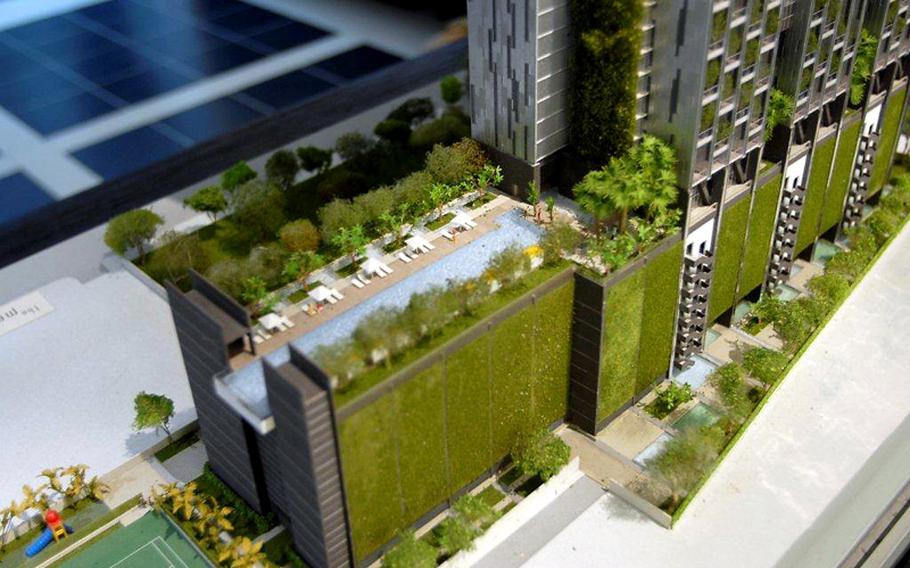
This model depicts The Met, a residential high-rise in Bangkok, Thailand. An exhibit at the German Architecture Museum in Frankfurt, Germany, highlights several of the innovative ways architects have incorporated greenery into urban settings. The Met won the Royal Institute of British Architects' Ubetkin Prize in 2011 for outstanding international architecture. (Kevin Dougherty/Stars and Stripe)
Museum exhibits bring life to subjects deemed worth showcasing. They convey information and perspective and promote reflection.
The German Architecture Museum in Frankfurt, Germany, is the country’s leading museum for building design and structure. Through April 29 it is presenting an exhibit called “Breathing Architecture” that showcases examples of urban buildings and complexes with open space, heavy vegetation and a communal feel.
Though intriguing, it’s not a new concept. It is also not all that common, particularly in highly populated cities peppered with towers of concrete and steel.
One exception is Southeast Asia, where architects in places such as Singapore, Thailand and India have designed projects that are airy, green and gentle in nature.
“It’s quite an unusual concept,” said museum spokeswoman Britta Köhler. In Singapore, for example, “they are trying to bring nature back into the city.”
In the tropics, living or working in a high-rise building can be uncomfortable, Köhler said. Air conditioners are not common, she noted, and room ventilation is often poor. The “concrete jungle” is anything but cool and lush.
The exhibit at the architecture museum pays tribute to recent efforts to spruce up urban sites. The solutions include gaps in buildings, hanging and crawling plants, garden spaces and even horizontal windows in bays and dormers. A rather ingenious idea, horizontal windows, allow air to circulate but won’t let the rain in.
One of four current exhibits at the museum, the “Breathing Architecture” display features floor plans, miniature models of award-winning projects and wall art of various types, such as murals and maps. Literature and the placards at each exhibit are in German and English.
Builders who “breathe,” so to speak, “strive to have open structures so air can circulate,” Köhler said. Of course, she added, “it depends on the climate what you can do.”
Because of the climates of North America and Europe, many of the building designs from Southeast Asia are not practical. Still, the overall approach makes sense, with modifications relating to geography. In Europe, architects who dabble in this style are vying for a project in Turin, Italy, Köhler said.
“It’s quite revolutionary,” she said of the approach.
Two other temporary exhibits at the German Architecture Museum feature designs from an area architect and the best of contemporary German architecture.
The one permanent exhibit is devoted to settlements through the ages and is aptly called “From primordial hut to skyscraper.” Each station includes a miniature model that depicts living conditions from that era.
The architecture museum is one of several along the Frankfurt Museum Riverbank, as it is known. The row includes museums devoted to art, film and Jewish life.
DirectionsThe German Architecture Museum, located in Sachsenhausen in central Frankfurt, is on the south side of the Main River in an area known as Museumsufer, or Museum Embankment. The street running in front of it and the other museums along that stretch is Schaumainkai. Address is Schaumainkai 43. Autobahns 3 and 5 provide the best approach. Look for signs to Zentrum and Sachsenhausen.
TimesThe museum is open at 11 a.m. on Tuesdays through Sundays. It closes at 6 p.m. on Tuesdays and Thursdays through Saturdays, 7 p.m. on Sundays and 8 p.m. on Wednesdays. Closed Mondays.
CostsTickets are sold in the museum’s bistro near the entrance for 7 euros. The price is half for students and handicapped individuals.
FoodThe bistro serves hot and cold drinks and light snacks.
InformationThe address is Schaumainkai 43 on the museum island. See its web, dam-online.de, or call its main number at (0)69-212-30835. doughertyk@estripes.osd.mil